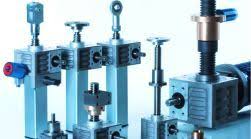Screw jacks are powerful tools, but their might demands respect. Proper safety measures during installation are paramount to ensure a secure and hazard-free operation. Here are some key steps to prioritize safety while installing your screw jack:
Planning and Preparation:
- Read the Manual: Thoroughly review the screw jack’s user manual before commencing installation. This manual will outline specific safety instructions and recommended installation procedures for your particular model.
- Identify Hazards: Before installation, assess the work area for potential hazards like electrical lines, falling objects, or pinch points. Take necessary precautions to mitigate these risks.
- Gather the Right Tools: Ensure you have all the necessary tools and equipment for the installation process, as specified in the user manual. Using the wrong tools can lead to improper installation or damage to the jack.
- PPE is Essential: Always wear appropriate personal protective equipment (PPE) during installation. This may include safety glasses, gloves, sturdy shoes, and hearing protection depending on the jack model and environment.
Installation Do’s and Don’ts:
- Secure Foundation: The screw jack’s base plate needs to be mounted on a solid, level surface that can withstand the jack’s lifting capacity. Improper mounting can lead to instability and potential tipping hazards.
- Lifting with Care: When lifting the screw jack into place, use proper lifting equipment and techniques to avoid back injuries. Seek help from a partner if necessary.
- Anchor Point Selection: Choose secure anchor points for the screw jack, as outlined in the user manual. These points should be strong enough to handle the pulling or pushing force exerted by the jack.
- Beware of Pinch Points: Be mindful of pinch points created during operation, such as between the screw and nut. Avoid placing fingers or other body parts near these areas.
- Overload Prevention: Never exceed the screw jack’s rated load capacity. Overloading can damage the jack and pose serious safety risks. Consult the user manual to determine the safe working load for your specific model.
- Test Before Operation: Once installed, conduct a test run of the screw jack without a load. Verify smooth operation and proper direction of movement before using it for lifting or positioning tasks.
Additional Safety Tips:
- Maintain a Clean Work Area: Keep the work area clean and free from debris to prevent slips, trips, and falls.
- Beware of Electrical Hazards: If the screw jack utilizes an electric motor, ensure all electrical connections are secure and meet safety regulations. Avoid operating the jack in wet or damp conditions.
- Proper Training: If necessary, provide proper training to personnel on the safe operation and maintenance procedures for the specific screw jack model.
Conclusion:
By prioritizing safety measures during screw jack installation, you lay the foundation for efficient and reliable operation. Remember, a few extra minutes spent on proper installation can prevent accidents and ensure the long-term safety of yourself and those around you.tunesharemore_vert

